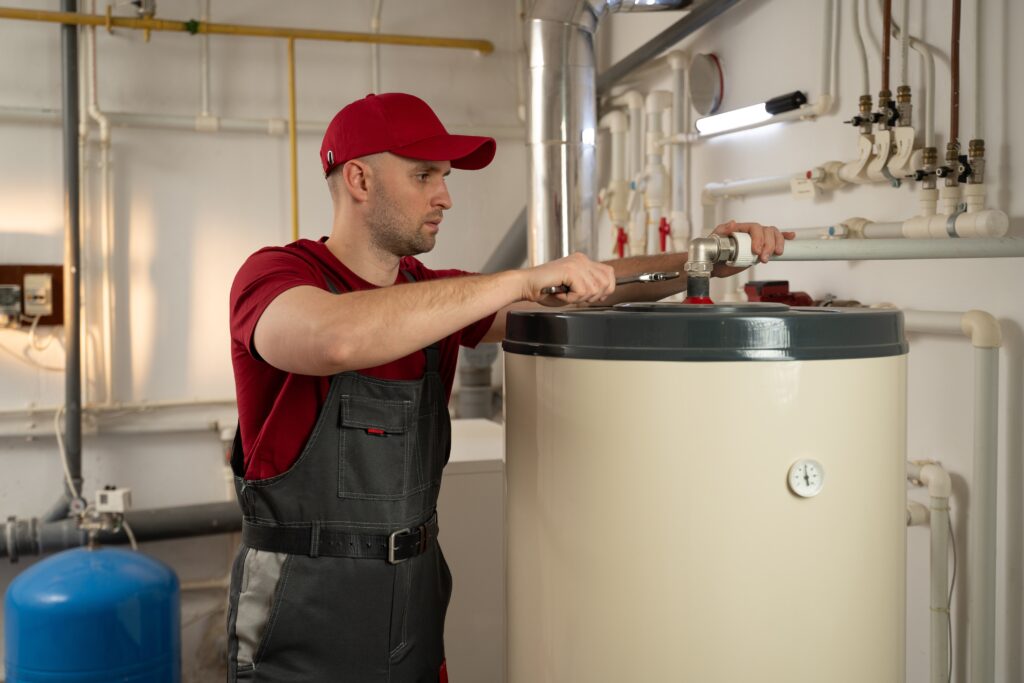Guide to Draining a Water Heater

Keeping your water heater in good shape might not be at the top of your to-do list, but it’s an important part of home maintenance. Over time, sediment and mineral buildup can collect inside the tank, making your water heater work harder and less efficiently.
Draining your water heater regularly helps flush out that buildup, improving performance and even extending its lifespan. Plus, it can save you money on energy bills and prevent unexpected breakdowns.
Most experts recommend draining your water heater at least once a year, but depending on your water quality, you might need to do it more often. Not sure where to start? Don’t worry—we’ve got you covered with this easy guide to draining your water heater and keeping it running smoothly.
Table of Contents
- Why You Should Drain Your Water Heater
- Signs Your Water Heater Needs Draining
- Step-by-Step Guide to Draining a Water Heater
- Common Mistakes to Avoid When Draining Your Water Heater
- When to Call a Professional
- Maintenance Tips
- FAQs
Why You Should Drain Your Water Heater
Draining your water heater might seem like an unnecessary chore, but it’s actually one of the best things you can do to keep it running efficiently and avoid costly problems down the road. Over time, minerals and sediment from your water supply settle at the bottom of the tank. If left unchecked, this buildup can lead to all sorts of issues, from inefficient heating to potential damage. Here’s why regular draining is so important:
1. Preventing Sediment Buildup
Every time you use hot water, minerals like calcium and magnesium naturally settle in your water heater. Over months or years, these particles form a thick layer of sediment at the bottom of the tank. This buildup can take up valuable space, reducing the amount of hot water your tank can hold and causing your heater to work overtime to keep up. By draining your water heater regularly, you can flush out these deposits and keep your system running smoothly.
2. Improving Heating Efficiency
When sediment builds up in the tank, it creates a barrier between the heating element and the water, making it harder for your heater to do its job. This means it takes longer to heat the water, and you might notice lukewarm showers or hot water running out faster than usual. Draining the tank helps remove this layer of sediment, allowing the heating element to work more efficiently and deliver hot water more quickly.
3. Reducing Energy Costs
A water heater struggling with sediment buildup has to work harder and longer to heat the water, which leads to higher energy bills. The harder your system works, the more energy it consumes—and that translates to more money out of your pocket. By performing regular maintenance, like draining the tank, you can help your water heater operate efficiently and keep your energy costs under control.
4. Preventing Damage and Leaks
Ignoring sediment buildup doesn’t just affect performance; it can also lead to serious damage over time. The excessive heat from trapped sediment can cause the tank to overheat, potentially leading to cracks, leaks, and even total system failure. Rust and corrosion are also common issues when sediment sits too long, which can result in costly repairs or the need for a full replacement. Draining your water heater regularly can help prevent these problems and extend the lifespan of your unit.
By staying on top of water heater maintenance and draining it at least once a year (or more often if you have hard water), you’ll enjoy better performance, lower energy bills, and peace of mind knowing your system is in good shape.
Signs Your Water Heater Needs Draining
Your water heater works hard behind the scenes to provide hot water for your daily needs, but like any appliance, it can show signs when it needs a little TLC. Over time, sediment buildup inside the tank can start causing problems that affect performance, efficiency, and even water quality. If you notice any of the following signs, it’s a good indication that your water heater is due for a drain and flush.
1. Rumbling or Popping Noises
Hearing strange noises coming from your water heater? That’s not a good sign. If you notice rumbling, popping, or cracking sounds when the heater is running, it’s likely due to sediment buildup at the bottom of the tank. As the heating element warms up, trapped sediment can cause small pockets of steam to form, creating those odd noises. Ignoring this can lead to overheating and potential damage to your heater, so it’s best to address it sooner rather than later.
2. Reduced Hot Water Supply
If your showers are turning cold faster than usual or you’re running out of hot water when doing dishes, sediment buildup could be to blame. When minerals settle at the bottom of the tank, they take up space that should be used for storing hot water. This means you get less available hot water before the tank needs to refill and reheat. Draining your water heater can help restore its capacity and ensure you have enough hot water for your household needs.
3. Discolored or Rusty Water
Have you noticed your hot water looking a little off? If it’s coming out rusty, cloudy, or has a strange odor, it could mean there’s a buildup of sediment or even corrosion inside the tank. This is especially common in older water heaters or in areas with hard water. Flushing the system can help clear out rust and sediment, improving your water quality and preventing further damage to your plumbing fixtures and appliances.
4. Higher Energy Bills
If your energy bills have been creeping up without any changes in your usage, your water heater might be working harder than it should. Sediment buildup forces the heating element to use more energy to heat the water, leading to inefficiency and increased costs. Regularly draining the tank helps your heater run more efficiently, keeping those utility bills in check and ensuring your system isn’t overworking itself.
If you’re experiencing any of these issues, it’s a clear sign your water heater needs attention. Draining and flushing your unit regularly can help you avoid costly repairs, extend the lifespan of your heater, and keep your hot water flowing smoothly.
Step-by-Step Guide to Draining a Water Heater
Draining your water heater might seem like a daunting task, but with the right steps, it’s actually pretty straightforward. Whether you’re dealing with sediment buildup or just performing routine maintenance, following these simple steps will help you get the job done efficiently and safely. Let’s walk through the process step by step.
Step 1: Turn Off the Power Supply
Before you do anything, safety first! Turning off the power supply is crucial to prevent accidents and protect your water heater from damage.
- For electric water heaters: Locate your home’s electrical panel and switch off the breaker that powers the water heater. This prevents any risk of electric shock while you work.
- For gas water heaters: Turn the thermostat to the “pilot” setting or completely turn off the gas supply using the shut-off valve. This ensures no gas is flowing while you drain the tank.
Taking this step ensures you’re working safely and prevents the heating element from running without water, which could cause it to burn out.
Step 2: Shut Off the Water Supply
Next, locate the cold water supply valve, usually found at the top of your water heater, and turn it off. This stops additional water from entering the tank while you drain it. If you skip this step, you’ll end up with a constant flow of water that makes draining nearly impossible.
Step 3: Attach a Hose to the Drain Valve
Grab a standard garden hose and attach it to the drain valve, typically located near the bottom of the water heater. Make sure the hose is securely fastened to prevent leaks. Run the other end of the hose to a nearby drain, a bucket, or even outside if possible. Just be mindful of where the hot water will go—avoid areas where it could cause damage or create a mess.
Step 4: Open the Pressure Relief Valve
The pressure relief valve helps release any built-up pressure inside the tank, making it easier for the water to drain out smoothly. This valve is usually found on the side or top of the tank. Simply lift or twist the valve handle to open it—don’t be surprised if you hear a slight hissing sound, as it’s just the pressure escaping.
Step 5: Drain the Tank Completely
Now it’s time to let the water flow! Open the drain valve where you attached the hose and let the water empty out of the tank. Depending on how much sediment has built up, the draining process might take anywhere from a few minutes to half an hour. Keep an eye on the water coming out—if it looks murky or filled with debris, your tank likely had a fair amount of sediment buildup.
Step 6: Flush Out Remaining Sediment
Once most of the water has drained, it’s a good idea to flush out any remaining sediment. To do this, turn the cold water supply back on for a few minutes while the drain valve is still open. This helps push out any leftover gunk and ensures your tank is completely clean. Keep flushing until the water runs clear.
Step 7: Close Valves and Refill the Tank
After flushing, it’s time to put everything back in order. Close the drain valve tightly and remove the hose. Then, shut the pressure relief valve and turn the cold water supply back on. You’ll hear the tank filling up—leave a nearby hot water tap open to let air escape from the pipes and prevent airlocks.
Step 8: Restore Power and Check for Leaks
Once the tank is full and air bubbles are out, it’s safe to restore power.
- For electric heaters: Flip the circuit breaker back on.
- For gas heaters: Relight the pilot light if needed and set the thermostat to your preferred temperature.
Finally, take a few minutes to check for any leaks around the drain valve or other connections. If everything looks good, you’re all set!
Common Mistakes to Avoid When Draining Your Water Heater
Draining your water heater might seem pretty straightforward, but there are a few common mistakes that can turn a simple maintenance task into a bigger headache. Whether you’re doing this for the first time or you’re a seasoned DIYer, here are some pitfalls to watch out for and how to avoid them.
1. Forgetting to Turn Off the Power
This might seem like a no-brainer, but it’s one of the most critical (and often overlooked) steps. Forgetting to turn off the power to your water heater—whether it’s gas or electric—can result in serious damage. For electric heaters, the heating elements can burn out if they’re left on without water inside the tank, leading to costly repairs. With gas heaters, you risk potential gas leaks or other safety hazards. Always take a moment to switch off the power at the breaker (for electric heaters) or turn the gas valve to “pilot” or off before starting. It’s a simple step that can save you a lot of trouble.
2. Not Draining the Tank Completely
It’s easy to get impatient and think you’ve drained enough water after a few minutes, but failing to empty the tank fully can leave behind stubborn sediment that continues to accumulate over time. Residual sediment buildup can reduce your heater’s efficiency and lead to rust, corrosion, and even leaks down the line. Be sure to let all the water drain out completely before closing the valve. If the water is still coming out cloudy or filled with debris, keep draining until it runs clear. Patience is key!
3. Skipping the Sediment Flush
Draining the tank removes most of the water, but without a proper flush, some sediment can still linger at the bottom. Many homeowners make the mistake of skipping this step, thinking the initial drain is enough. Flushing the tank by briefly turning the cold water supply back on while the drain valve is open helps dislodge any remaining gunk, ensuring your tank is truly clean. This extra step helps prevent buildup, keeps your heater running efficiently, and extends its lifespan.
4. Over-Tightening the Drain Valve
It’s tempting to crank down on the drain valve to ensure it’s fully closed and leak-proof, but over-tightening can actually do more harm than good. Water heater drain valves are usually made of plastic or soft metal, which can crack or strip if too much force is applied. A damaged valve can lead to persistent leaks, requiring a full replacement. Instead, tighten the valve just enough to stop any dripping—if it continues to leak, consider replacing the washer or using plumber’s tape instead of forcing it closed.
By avoiding these common mistakes, you’ll keep your water heater running efficiently and save yourself from unnecessary repairs or replacements. Taking the time to do it right means fewer issues, lower energy bills, and plenty of reliable hot water when you need it.
When to Call a Professional
While draining your water heater is a task many homeowners can tackle on their own, sometimes it’s best to bring in a professional. If you notice leaks around the tank, fittings, or valves, it’s a sign that something might be wrong beyond just sediment buildup. Even a small leak can lead to bigger issues like water damage, mold growth, or a complete system failure if not addressed properly. A licensed plumber can assess the situation and make sure your water heater is in good working condition—or recommend a replacement if necessary.
Persistent sediment issues are another reason to call in the pros. If you’ve drained and flushed your tank multiple times but still notice rusty water, strange noises, or reduced efficiency, there may be deeper mineral deposits or internal damage that require specialized tools to fix. This is especially common in areas with hard water, where buildup can happen quickly and be tough to remove completely.
Older water heaters can also pose a challenge. If your unit is over 10 years old, it might not respond well to DIY maintenance. Older tanks can have corroded parts, fragile components, or outdated valves that are more prone to breaking during draining. A professional can safely handle these delicate units and advise you on whether it’s time to repair or replace your heater to avoid unexpected breakdowns. When in doubt, it’s always better to err on the side of caution and get expert help to keep your hot water running smoothly.
Maintenance Tips
Keeping your water heater in top shape doesn’t require a ton of effort, but a little regular maintenance can go a long way in extending its lifespan and ensuring it runs efficiently. By staying on top of a few key tasks, you can avoid costly repairs and enjoy consistent hot water when you need it. Here are some easy maintenance tips to keep your water heater performing at its best.
1. How Often to Drain Your Heater
Draining your water heater is one of the simplest and most effective ways to keep it running efficiently. Most experts recommend draining it at least once a year to flush out sediment and mineral buildup that can reduce performance. However, if you live in an area with hard water, you might want to do it every six months to prevent excessive buildup. A regular draining schedule helps your heater work more efficiently, saving you money on energy bills and preventing unexpected breakdowns.
2. Checking the Anode Rod
The anode rod is a crucial but often overlooked part of your water heater. This metal rod, usually made of aluminum or magnesium, is designed to attract corrosive elements in the water, protecting the tank from rust and corrosion. Over time, the anode rod wears down and needs to be replaced. Checking it every couple of years (or sooner if you have hard water) can help prevent rust from damaging the tank. If the rod is heavily corroded or less than half its original size, it’s time to swap it out to keep your heater in good shape.
3. Insulating Your Tank for Efficiency
Want to make your water heater more energy-efficient? Insulating the tank is a simple way to do it. A water heater insulation blanket can help reduce heat loss, allowing your heater to maintain water temperature more effectively and use less energy. This is especially useful if your heater is located in a colder area like the basement or garage. Additionally, insulating exposed hot water pipes can prevent heat loss as water travels to your faucets, further improving efficiency and cutting down on energy costs.
4. Watching for Early Warning Signs of Issues
Catching problems early can save you from major headaches later on. Keep an eye (and ear) out for signs like strange noises (popping or rumbling sounds), fluctuating water temperatures, rusty water, or water pooling around the base of the unit. These could be signs of sediment buildup, corrosion, or even a potential leak. Addressing these issues early, whether by draining the tank, replacing a worn part, or calling in a professional, can prevent more serious damage and extend the life of your water heater.
By following these simple maintenance tips, you can keep your water heater running smoothly for years to come. A little effort now can help you avoid cold showers and costly repairs down the line!
Conclusion
Draining your water heater might not be the most exciting household task, but it’s one that pays off in the long run. Regular maintenance helps prevent sediment buildup, improves heating efficiency, reduces energy costs, and extends the lifespan of your unit. By taking the time to drain and flush your heater once a year (or more often if you have hard water), you can avoid unexpected breakdowns and keep your hot water flowing when you need it most.
Staying on top of water heater maintenance doesn’t have to be overwhelming. A little effort goes a long way in preventing costly repairs and ensuring your heater runs smoothly for years to come. Whether it’s draining the tank, checking the anode rod, or insulating for better efficiency, these small steps can make a big difference. Plus, if you ever feel unsure, don’t hesitate to call in a professional to lend a hand.
Finally, always keep safety in mind when working on your water heater. Remember to turn off the power or gas supply before draining, and be cautious when handling hot water. Taking the proper precautions ensures a safe and successful maintenance routine.
FAQs
1. How long does it take to drain a water heater?
The time it takes to drain your water heater depends on the size of your tank and how much sediment has built up. On average, it takes about 20 to 45 minutes for a typical 40- to 50-gallon tank to drain completely. If there’s a lot of sediment, it may take longer, and you might need to flush the tank multiple times to clear it out fully.
2. Can I drain my water heater without turning it off?
No, it’s not recommended. Draining your water heater while it’s still powered on can damage the heating elements (in electric models) or pose safety risks with gas units. Always turn off the power at the breaker or set the gas valve to “pilot” before starting the draining process to avoid damage and ensure safety.
3. What if my drain valve is clogged?
If your drain valve is clogged with sediment, try gently poking a wire or coat hanger inside the valve to break up the blockage. You can also turn the cold water supply on briefly to help flush out debris. If the valve remains clogged, you may need to replace it or call a professional for assistance.
4. Is draining necessary for tankless water heaters?
Tankless water heaters don’t store water like traditional units, but they can still accumulate scale buildup, especially in areas with hard water. Instead of draining, they require periodic descaling to remove mineral deposits and keep the heating elements efficient. Most manufacturers recommend flushing a tankless unit with a descaling solution at least once a year to maintain performance.
Additional Home Improvement Resources

Anna has over six years of experience in the home services and journalism industries and serves as the Content Manager at MyHomePros.com, specializing in making complex home improvement topics like HVAC, roofing, and plumbing accessible to all. With a bachelor’s degree in journalism from Auburn University, she excels in crafting localized, comprehensive guides that cater to homeowners’ unique needs. Living on both coasts of the United States has equipped her with a distinctive perspective, fueling her passion for turning any house into a cherished home through informed, personalized decision-making.
Connect with top-rated local contractors who can help you with siding, roofing, HVAC, windows, and more. Get free quotes from verified professionals in your area today.








